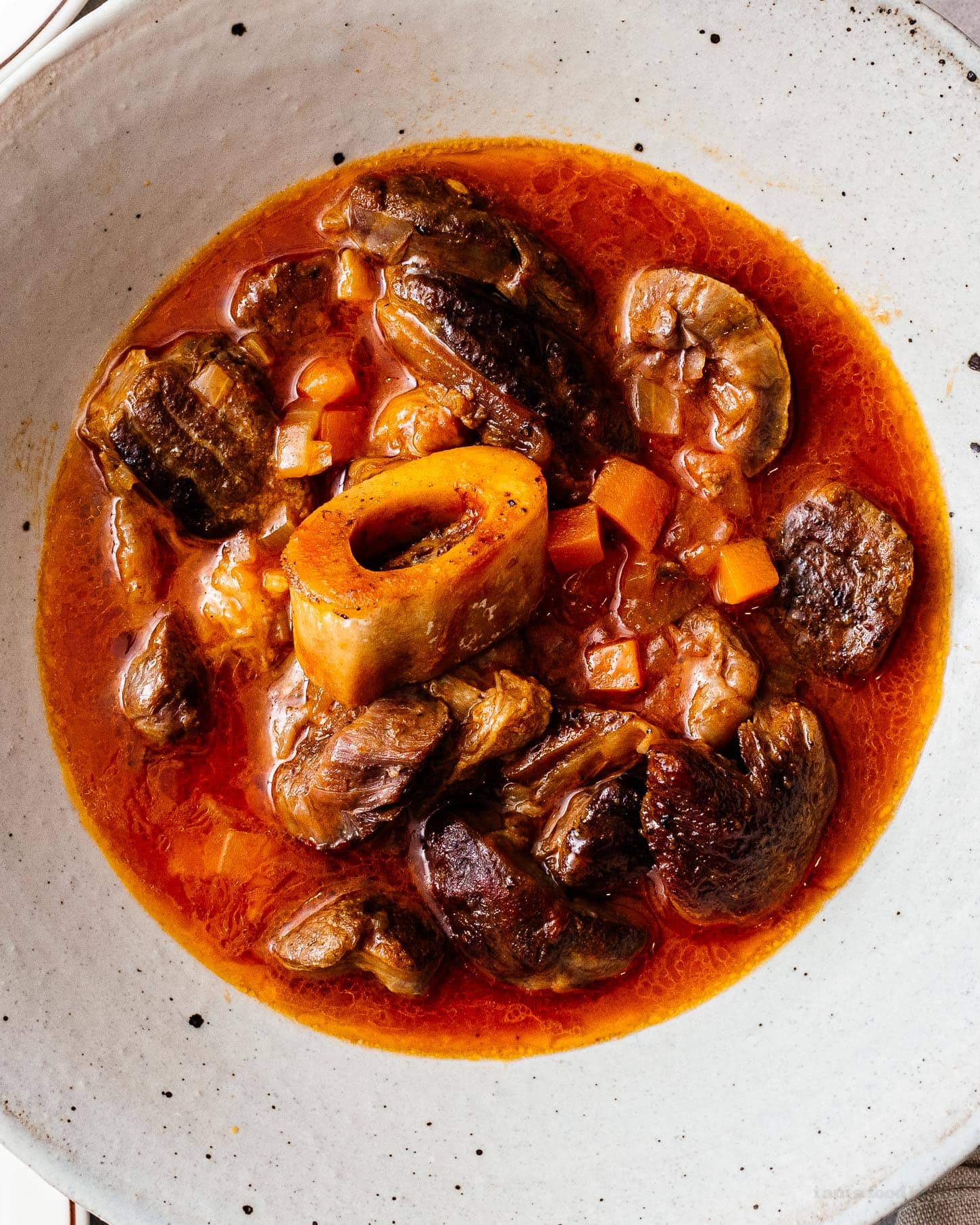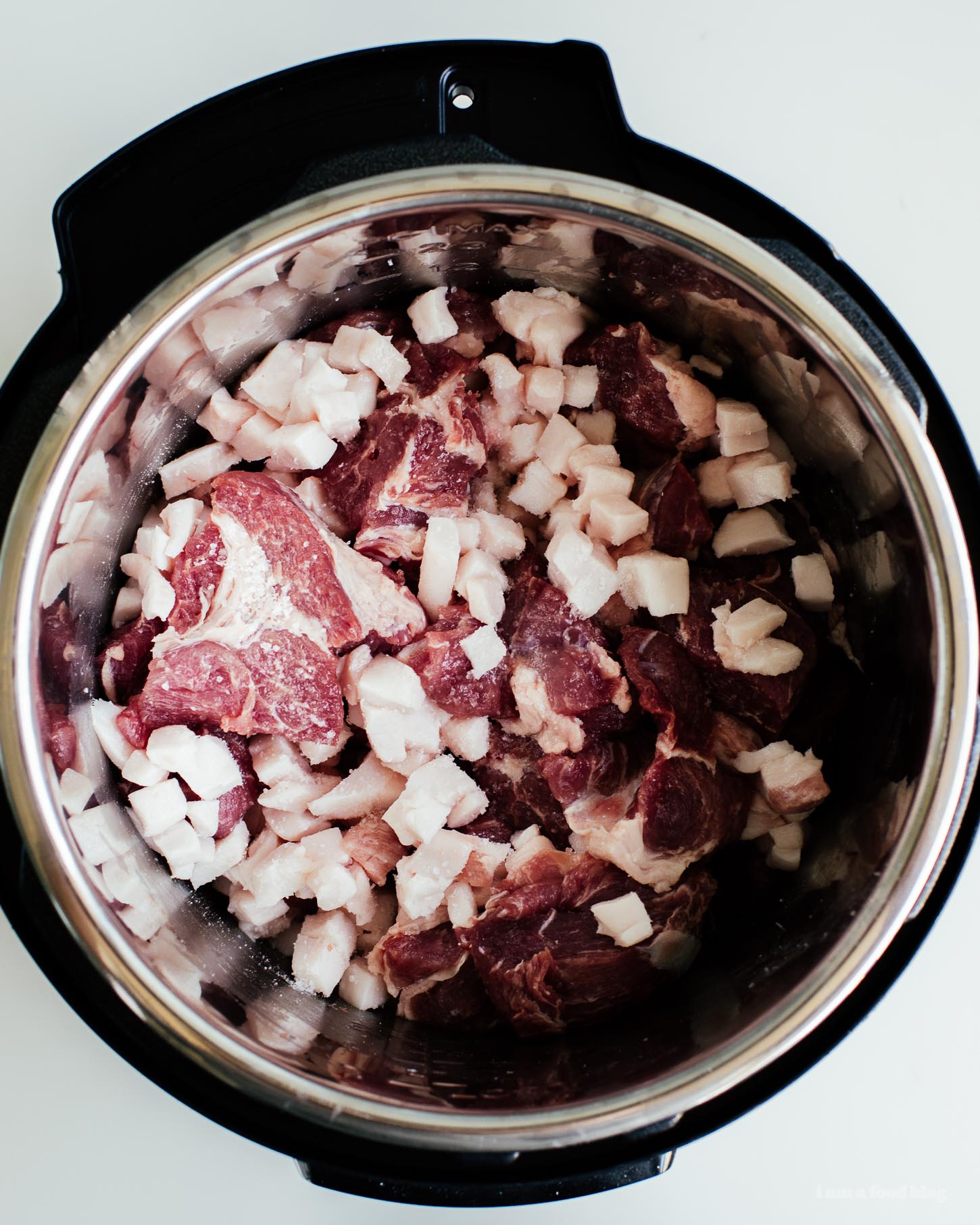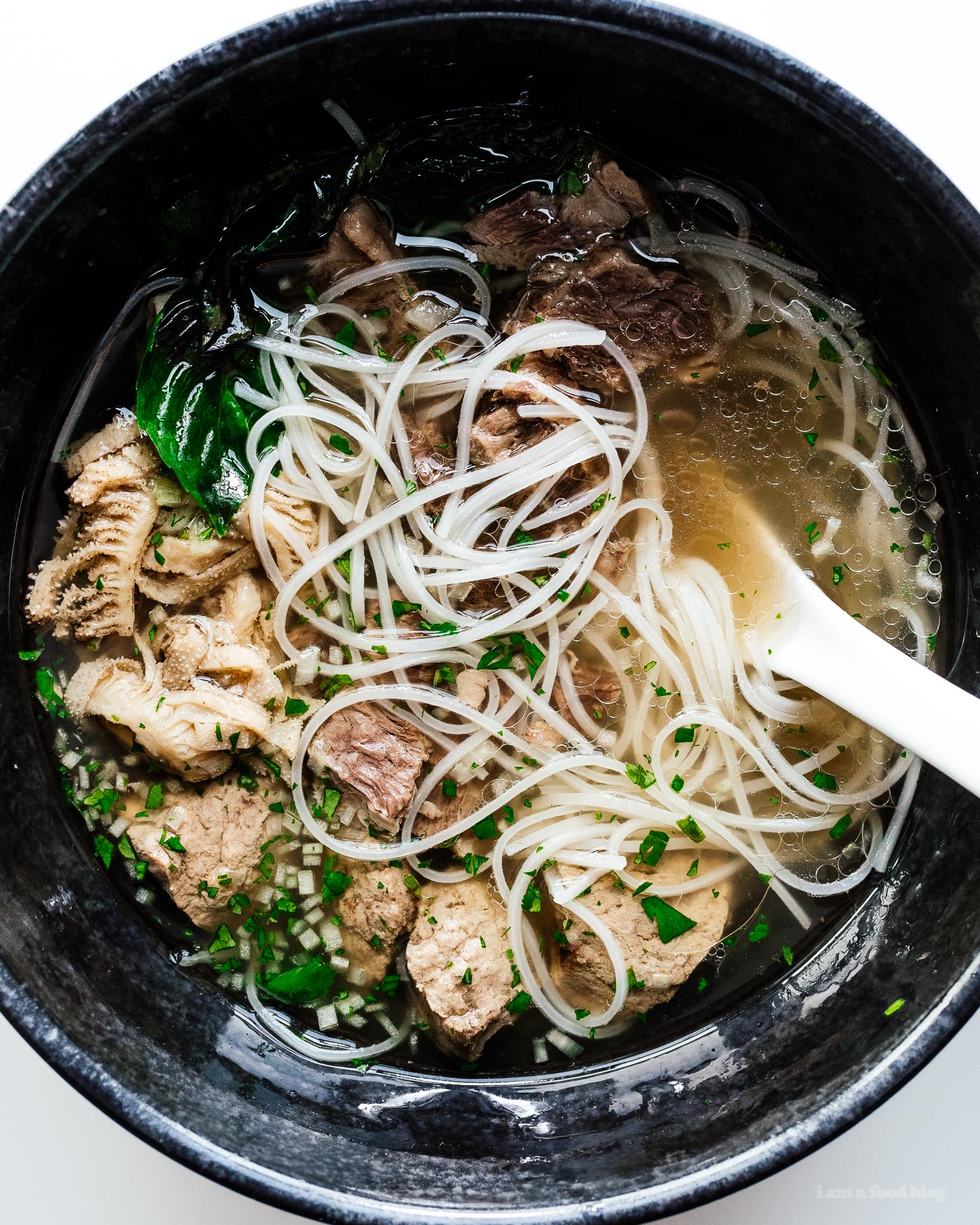
Pho is maybe the world’s most universally beloved soup. If you want to fill up on some deep pho love and geekery, read on, or if you would like to just make the best, most authentic pho you’ve ever made at home, feel free to jump to the recipe using these handy links:
- Pho
- Why is authenticity important?
- What is pho?
- Pho soup
- Pho noodles
- Meats
- Toppings & garnishes
- Bowls
- How to make pho
- How to pronounce pho
- Pho variations
- Just skip to the recipe
Pho
Like many Vietnamese families who escaped Vietnam after the war, my family was dirt poor and just starting over when I was growing up. The first month dad started a business, we only had $20 left over for food, so that month we ate nothing but instant noodles. I love instant noodles so never saw a problem with that situation then or now, but even today my dad always feels bad when the topic comes up.
Food is really, really important in my family. When my mom was a young girl in Vietnam, she made a living selling food at the market, and always bought herself something different at the market to eat each day as well. Except for that one hard month, we had a tradition that every Saturday morning we would always go out for lunch as a treat, and that treat was almost always pho. Back in the 80s, pho was less than $5 a bowl, and that made it possible for a young family to get out and have a little bit of fun in between all the hard work. And, just like my mom did when she was young, each weekend our family would go someplace different to try out their pho.
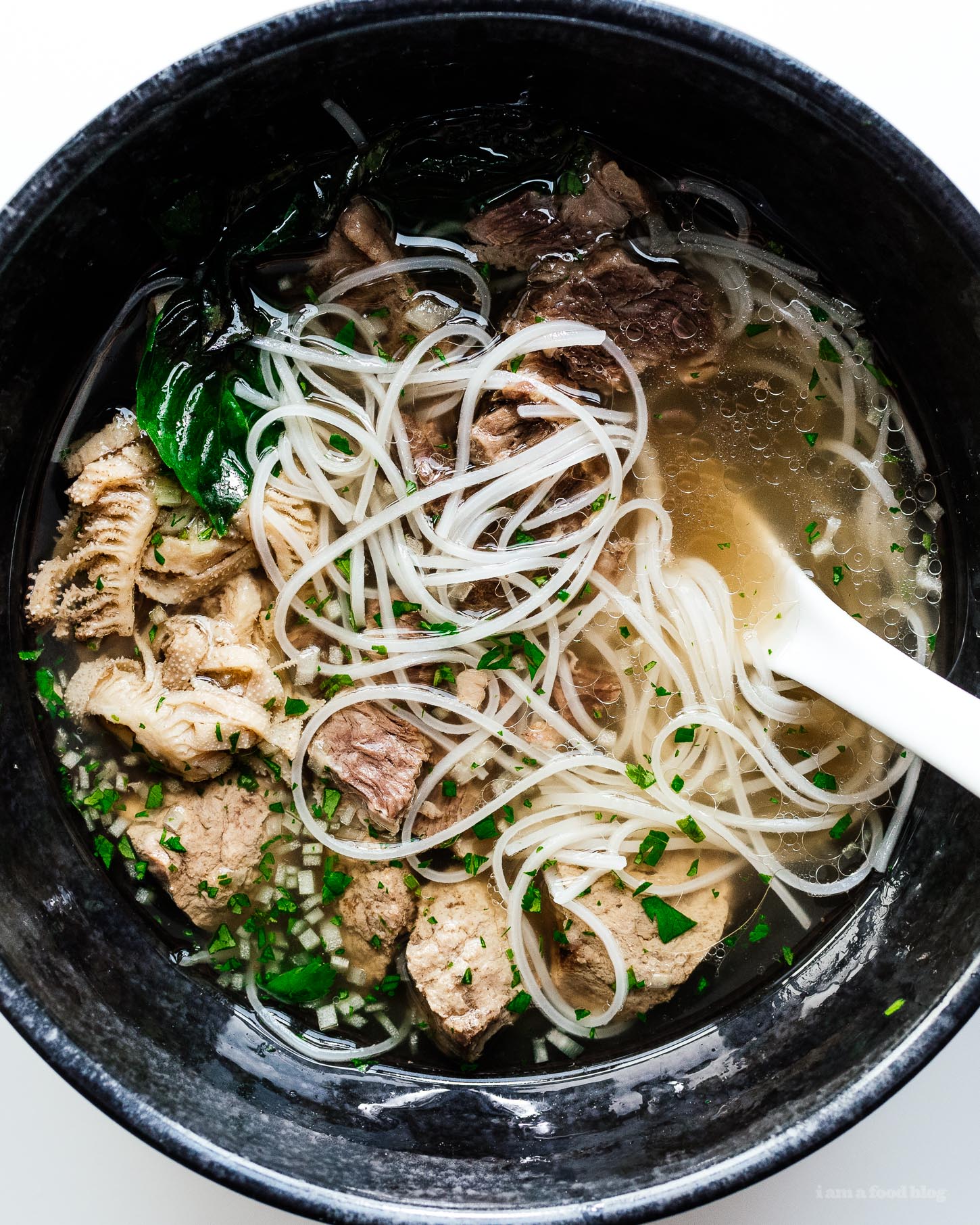
A few years after Steph and I got married, we did pretty well and were lucky enough to be able to go travelling for a bit, and – without knowing the above story – Steph insisted that we always try a pho place in each city we visit. We were already married but I realized then that this girl was definitely meant for me.
I’m pretty confident that I’ve personally eaten at hundreds of different pho restaurants with my parents growing up, and Steph and I have had pho in places as far and wide as Switzerland, Spain (shown below), Colombia, Singapore, Hong Kong, Tokyo, and of course, most any major city in North America. Nowadays, either one of us can (and often do) whip up a pho from scratch that rivals any restaurant we’ve been to.

Why is authenticity important?
I hadn’t planned on updating this post, which was originally written in 2017, but I’ve come to realize it bothers me that the top recipe when you search pho is an allrecipes claiming to be “authentic” that doesn’t include a single spice and is probably not even written by anyone remotely Vietnamese. I think I would have preferred Jeremy Clarkson’s version.
In 2020, I probably don’t need to talk about the importance of voices and platforms, but I do want to mention: Just like how taco bell set back America from enjoying really, really good Mexican food for decades, calling bad pho recipes ‘authentic’ just ruins it for good, proper Vietnamese recipes and techniques. Do you need to be Vietnamese to make or enjoy pho? Absolutely not. Should you follow a recipe with Vietnamese roots when you want to make pho? Absolutely.
What is pho?
Pho (properly made) is a deeply spiced and aromatic soup of a clear broth and rice noodles, topped with different cuts and textures of meats and fresh herbs. It doesn’t need to be meat, and in fact many Vietnamese have vegan pho, but it’s by default beef noodle soup, which is what this recipe is for. This recipe is the culmination of many years of making pho, and more importantly, even more years eating pho. It won’t steer you wrong.
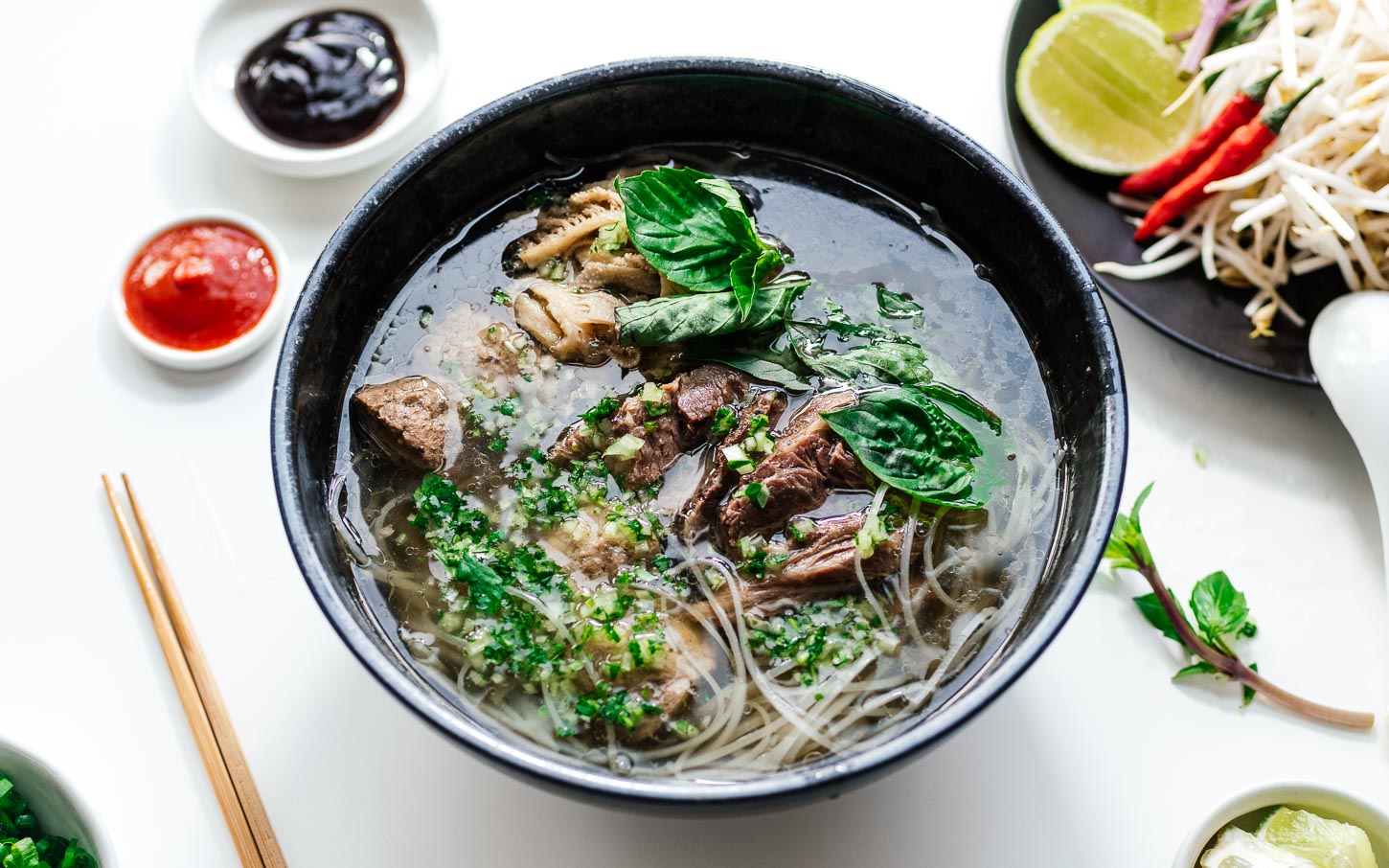
Pho soup
A great pho soup is a well made beef broth with charred aromatics, sweetened with sugar, and seasoned with fish sauce. The signature taste of beef pho though comes from the charred aromatics and spices: if you leave those out, you don’t have pho, you have generic beef noodle soup.
Bones vs Meat
Traditionally pho soup was made with bones, but I prefer a cheap cut of meat. Where we live, bones cost more or less the same as cheap beef because of the popularity of bone broth and marrow. Lately we’ve gravitated towards a cut from the ribs called finger meat (shown below) which I feel has the perfect ratio of connective tissue, fat, and meat to make an incredible pho soup. Using a cut of meat with some connective tissue and fat goes a long way, but any cheap cut of meat, soup bones, or a mix of both will do. I’m a sucker for whatever is on sale. You won’t be throwing away the meat once the pho is made either, so there’s no wastage if you go the meat route.
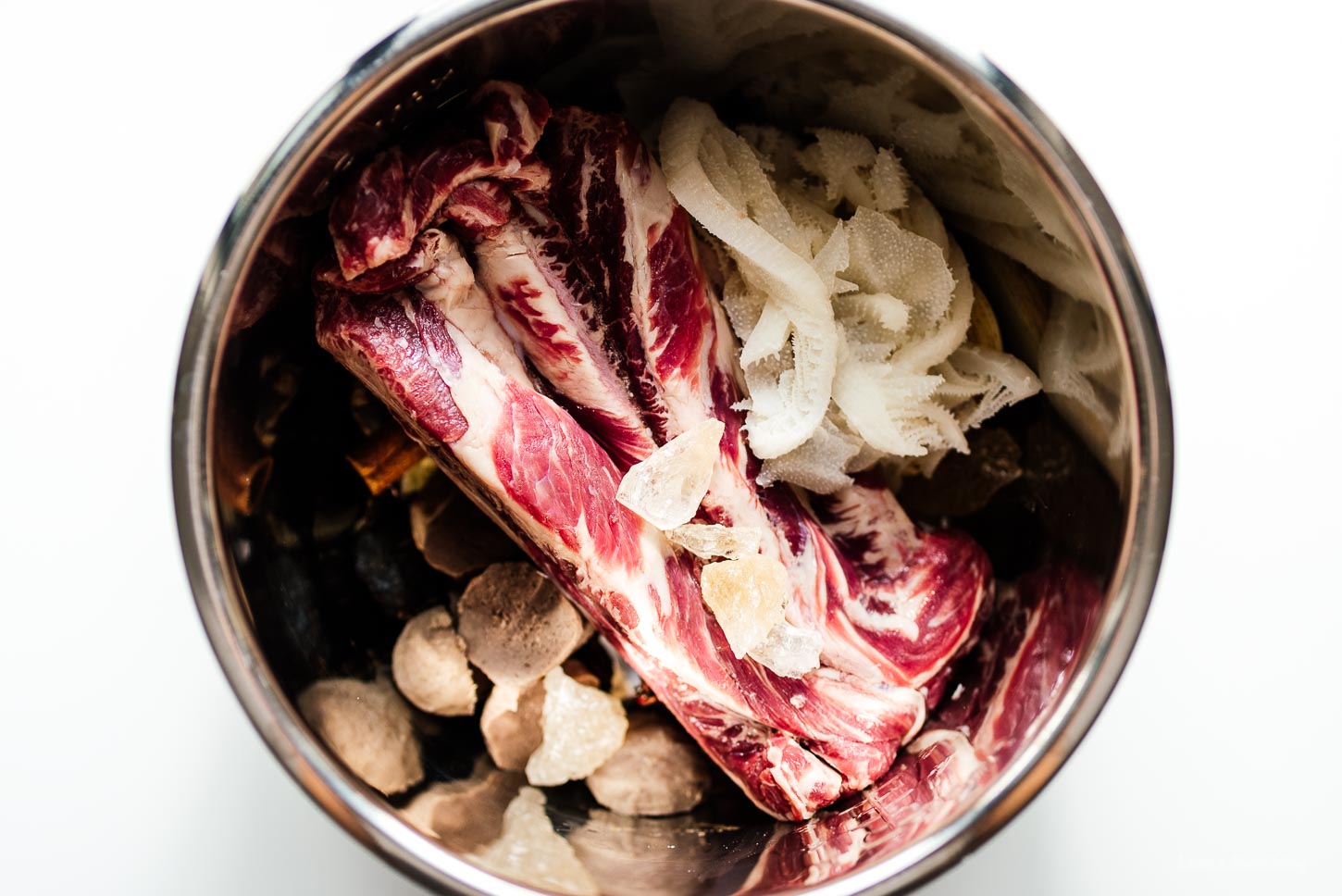
Charred Spices & Aromatics
Charred aromatics are the most important part of a great pho soup. It’s the first thing I learned from my parents when we made pho at home, especially charring the onion. My dad says it’s not even pho if you don’t do that.
The easiest way to char your aromatics is by putting them on a sheet tray and blow torching them all at once. While everyone needs a good blow torch because they’re cheap and insanely useful in the kitchen, you can also char over a gas range, on an outdoor grill, in the oven/broiler, or in a cast iron pan. If you’re charring over a gas range or even with a blowtorch, just char the larger items: ginger, onions/shallots, cinnamon stick, and star anise.
You’ll see daikon in the recipe list as well. That’s my mom’s secret ingredient (it’s a lot of people’s secret ingredient). You don’t need to/can’t toast that.
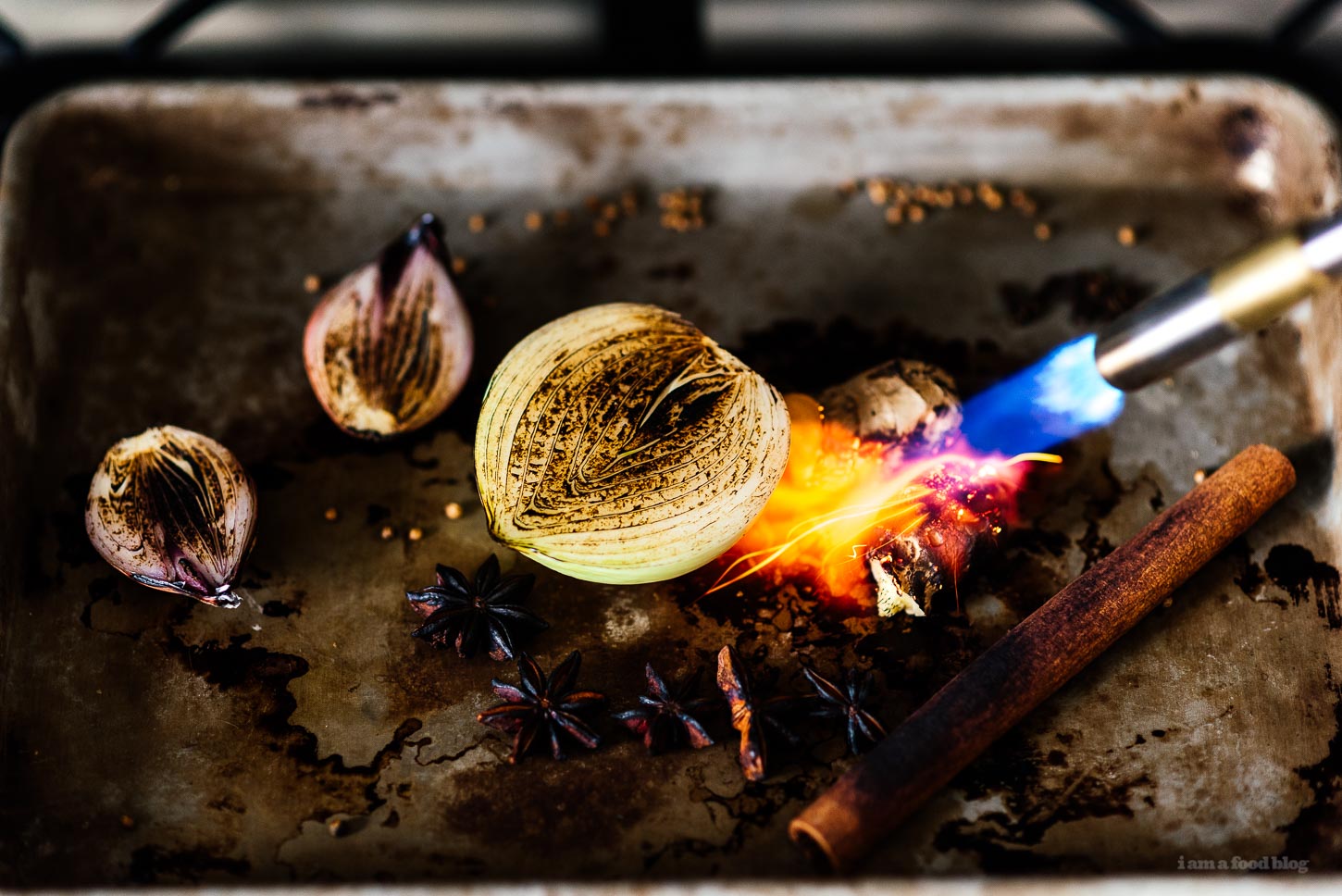
Fat content
Every good noodle soup needs fat for the broth to stick to the noodle and pho is no exception. If you prefer to control the fat content of your pho (and can wait a few hours before eating) this is a trick I learned from Ivan Ramen‘s cookbook:
- Leave the pho in the fridge until the fat solidifies (typically 4-6 hours)
- Scoop only the fat out into a small saucepan.
- Melt it over low heat.
- Strain into a small container.
The fat will keep in the fridge for up to a week, and you can measure out exactly how much each bowl will have. Add at least a teaspoon to each bowl of pho you make; unless you’re crazy about living fat free, your tastebuds will thank you for it. For us though, we just go with whatever fat comes with the soup.
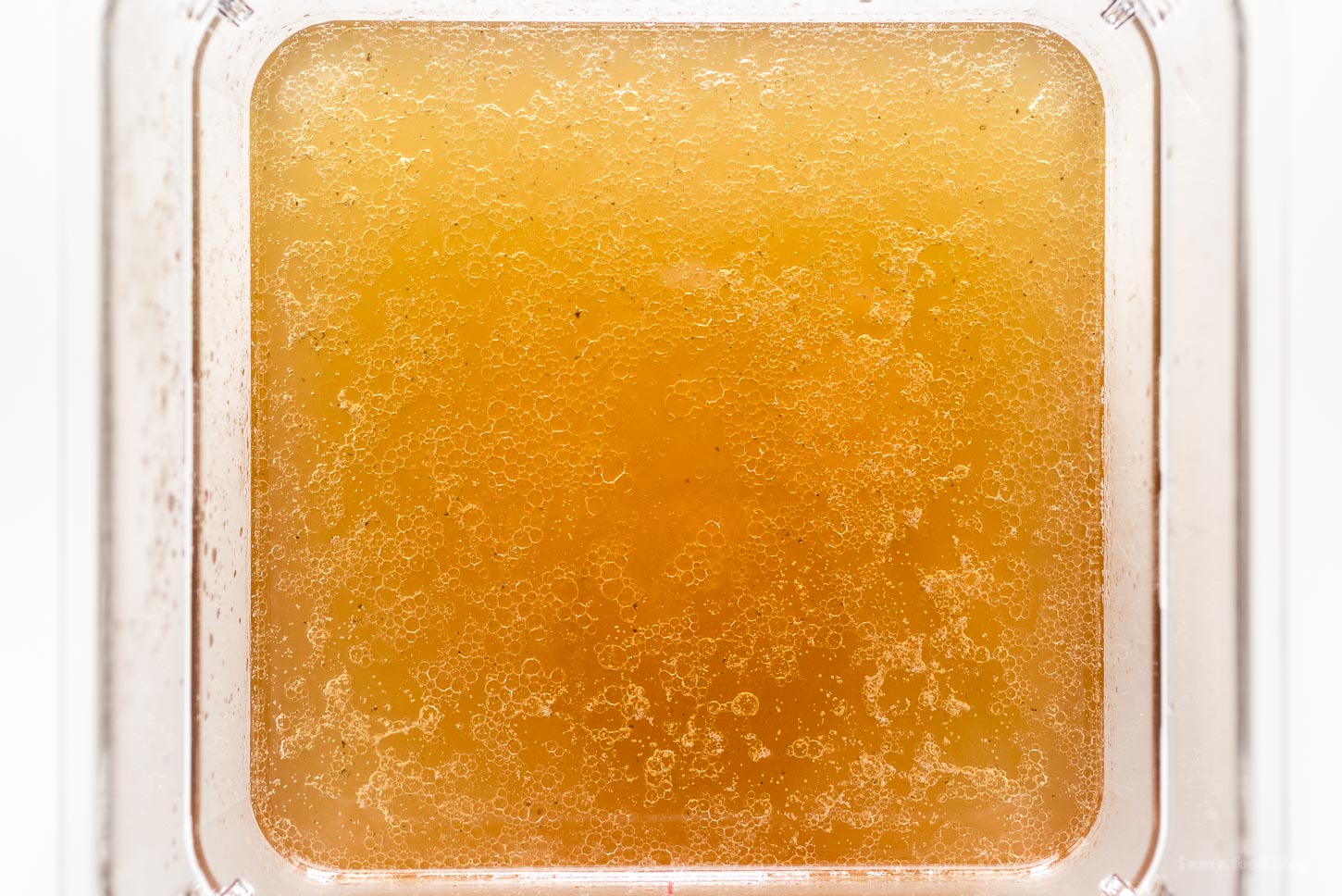
Seasoning: how to make a great pho
Pho is about balance, but not necessarily subtlety. Personally speaking, I like my pho to be extra. I’ll season my pho soup until it’s just on the verge of too sweet, then I add enough fish sauce to counter balance the sweetness and create a massive umami bomb. The blandness of the noodles and the brightness of the customary squeeze of lime at the table will temper all the craziness and bring the universe back into balance.
The sugar I prefer for pho is rock sugar, which you should be able to get in the Asian aisle of just about any supermarket, and definitely at every Asian supermarket. Some people traditionally use palm sugar. I wouldn’t say it’s totally worth the extra effort to get special sugar, but if you’re in the area already, rock sugar is delicious and very pretty. Regular white sugar is just fine though.
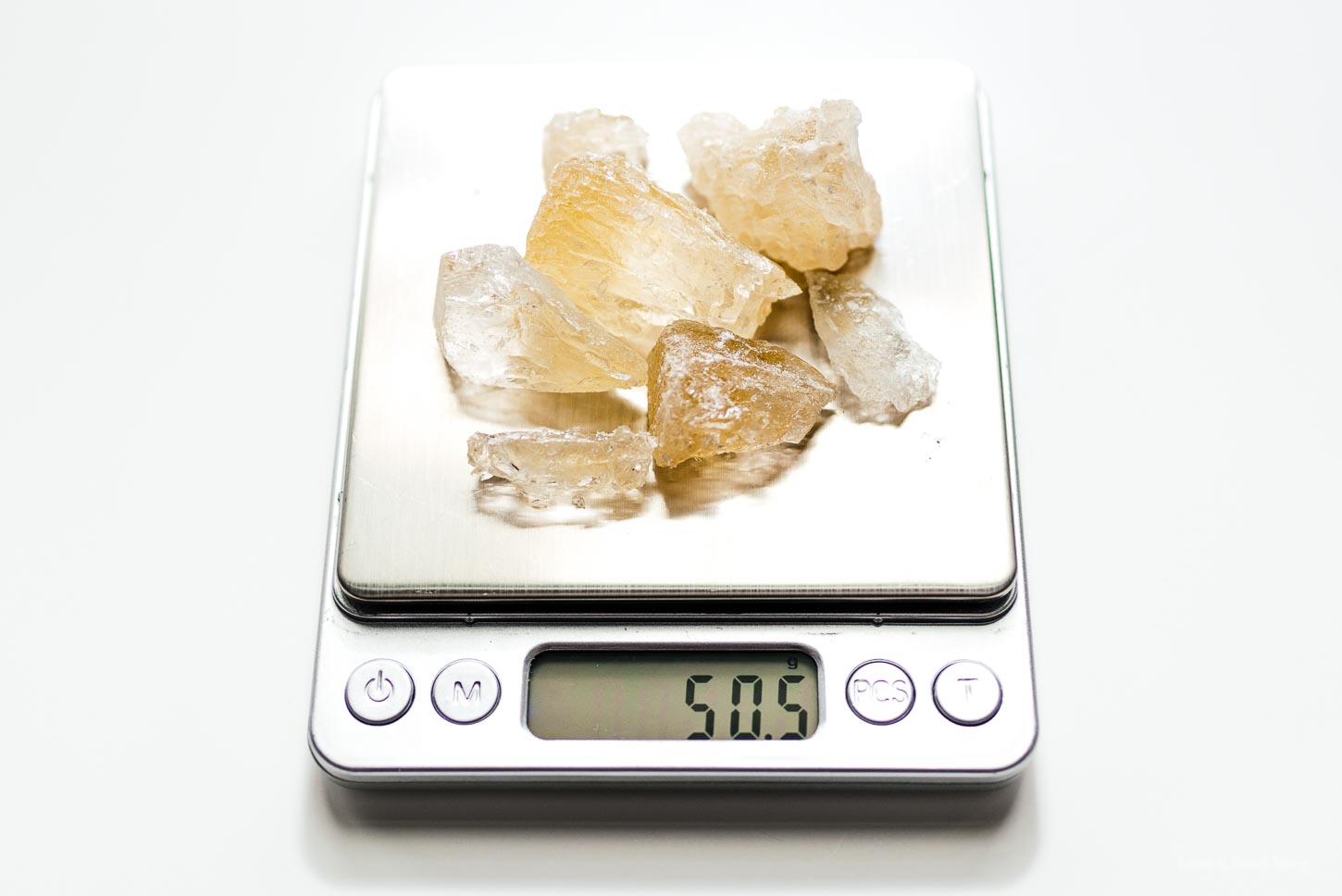
On fish sauce
Not all fish sauces are equal, and you really do get what you pay for, especially when you never pay more than $10 or so. If you aren’t shopping at an Asian grocery store, Red Boat is usually your best bet. If you’re at the Asian supermarket though, and see something called mắm nhĩ, go for that: it’s basically the equivalent of first press or extra virgin for fish sauce, and is always a good bet. Never, ever buy mắm nêm unless you are prepared to cook outdoors.
Do you even need fish sauce? No. It’s traditional, but it’s also traditional to use salt or a mix of both depending on how “clean” you want your pho to taste. My mom leaves out the fish sauce in favor of salt these days. I would never consider this. She says I’ll change my mind in 30 years.
Pho noodles
If you can, get fresh pho noodles, but if you can’t, the dried stuff works too. Sometimes the noodles will be called rice stick or Thai rice stick noodles. Medium thickness is best. Briefly blanch the noodles about halfway to your desired softness, then drain and rinse in cold water so they don’t stick too much. Allow them to dry out in a colander for 5-10 minutes while you prepare the other items.
Drying out the rice noodles seems counterintuitive since you just cooked them, but it’s the secret to flavorful noodles as they suck in the pho broth to rehydrate later.
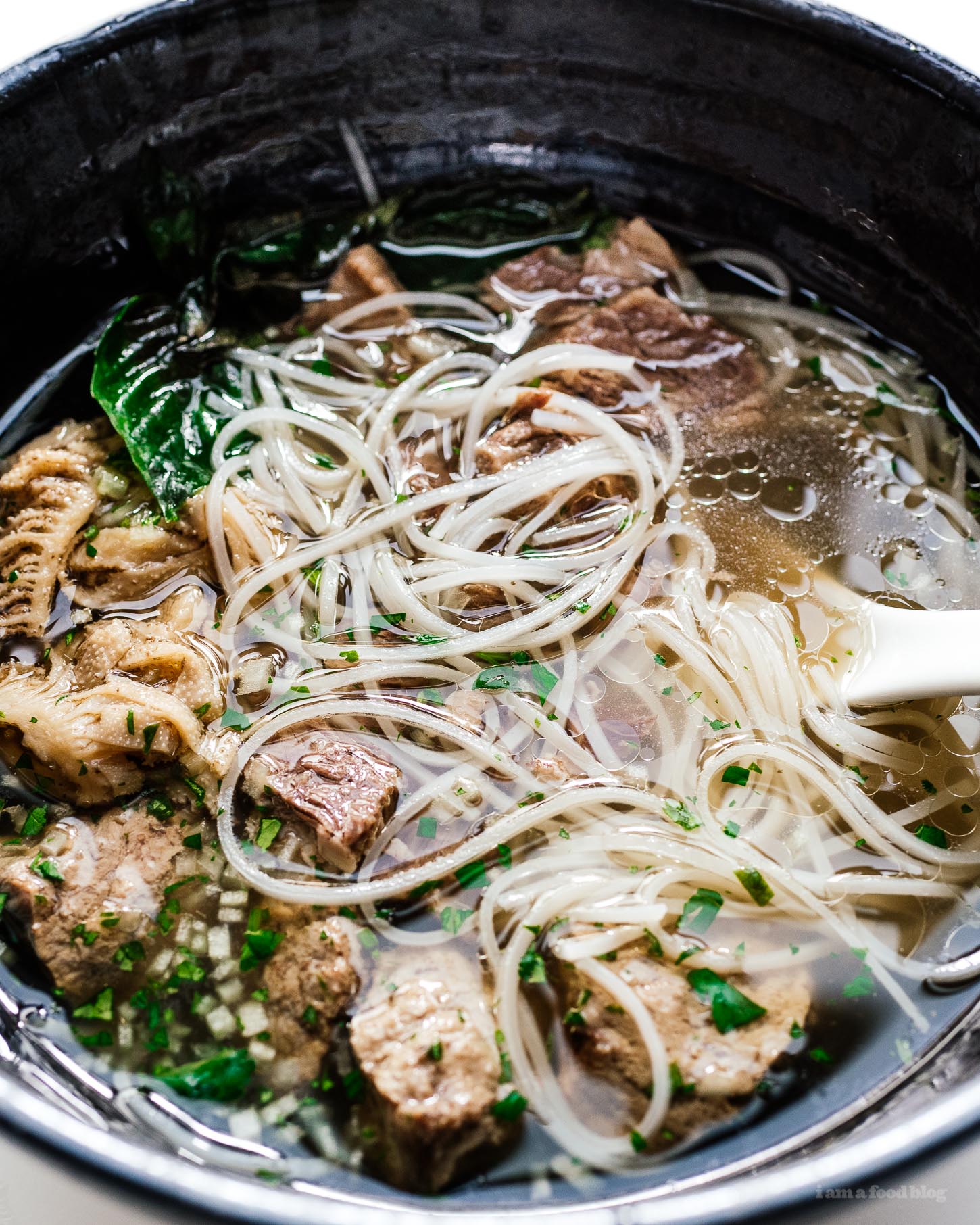
Meats
Pho is beloved not just for its broth but the meaty toppings. Sirloin, well done brisket, flank, tripe, meatballs, the list goes on and on. Anyone who has been eating pho for awhile will tell you that dặc biệt (house special), which is every meat the restaurant has, is the way to go, but at home, you may not want to go that nuts.
For me though, a good pho should have 2-3 different meats. If you make this with finger meat, flank, or brisket, you should have some nice well done meat, and to that I’d recommend some meatballs, sirloin that’s been thinly sliced and allowed to cook in the broth (buy sirloin roast to get the nice round pieces), and, for the truly adventurous, tripe/omasum.
Here is a primer on the major meats in pho and why they are awesome:
- Sirloin is the star of pho. It’s the default inclusion, it’s always there. You want it as thinly sliced as possible and cooked only in the soup. Traditionally much of it will be left out of the soup both so you can see how fresh and high quality the meat is, and so that the meat doesn’t overcook before it hits your table. It only needs about 30 seconds to cook in the piping hot broth.
- Vietnamese meatballs are bouncier and denser than what you’d typically think of meatballs as. Their traditional greyish color can be offputting at first, but their deliciousness will quickly retrain your mind to associate them with feelings of fullness and delirious satiety. Because of how dense these are, I like to halve them.
- Well done brisket or flank’s soft fall-apart-in-your-mouth texture is deeply satisfying, but so are the pho-full flavors they pick up in cooking in the pho broth for hours. Properly speaking, they should cook in the pho broth after it’s been made and seasoned, but if you are short on time, just cook them at the same time the pho broth is made. They won’t have as much flavor, but the texture will still be there. And, will you really notice the flavor as you dip it in your personalized mix of sriracha and hoisin anyway?
- Tendon is chewy, a little crunchy, and so satisfying in a bowl of otherwise very soft things. Tendon is extremely hard to find though, unless you go to a butcher or a specifically Vietnamese supermarket. Not even an Asian supermarket typically carries these, but if you see it, you should get it. Tendon should be chopped into bite sized pieces and added along with the bones as it takes hours to properly soften.
- Tripe/Omasum is another slightly crunchy textureful meat that doesn’t look as good as it deserves to. It’s always been my favorite part of pho. You want it thinly sliced and briefly blanched, 1-2 minutes. I blanch it in the noodle water to keep it white, but again, we can one pot this in the instant pot, it’s not that finicky.
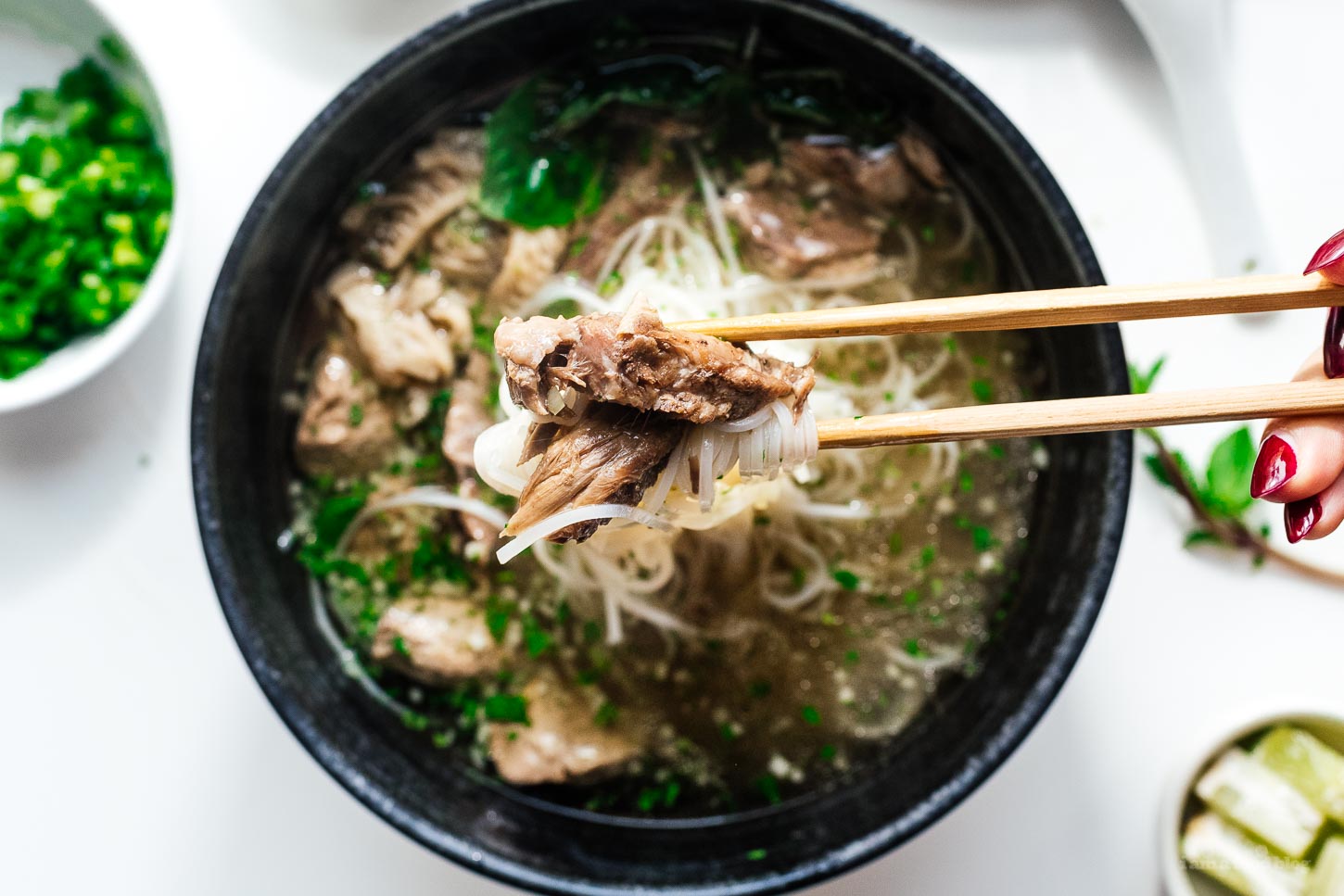
Toppings & Garnishes
Vietnamese food’s claim to fame are the fresh flavors and herbs and pho is no different:
- Sliced raw onions and chopped cilantro are basically mandatory in my pho. I realize both are separately polarizing to two different groups of people. They’re pretty important to me though.
- Thai basil is a must, but if you can’t get any, sweet basil is a sad-but-passable substitute.
- Limes add brightness and offset the salty-sweet-umami-bomb in your mouth.
- Vietnamese food is spicy, but pho isn’t, some say that’s because it originated in the less-spicy north. Regardless, Jalapeños or Thai chilies are always supplied to fix that issue for the people who love spice.
- Bean sprouts add an earthiness and sometimes crunch to your soup. Many people like to blanch their sprouts and judge a pho place based on whether they took the time to blanch the sprouts first. Other pho restaurants ask you if you want them blanched or not. For me, I don’t like them at all and skip them.
- Sriracha and hoisin sauce has been a fixture at pho restaurants since forever, even in Vietnam. Always feel welcome to add them to your soup and especially to make a dip out of them for your meats. They are 100% authentic, despite what Bon Appétit said about that (I still can’t believe they didn’t delete the tweet).
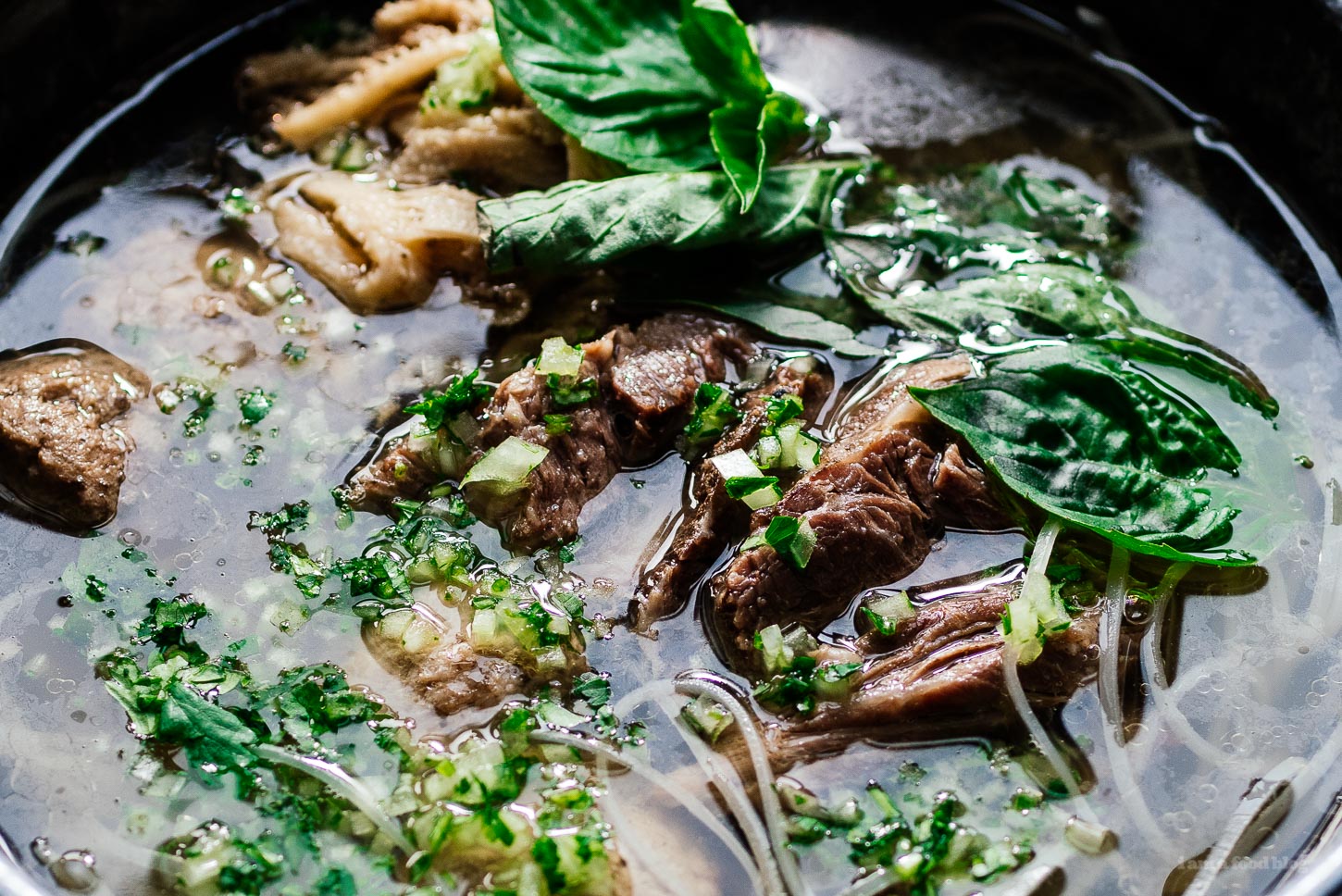
Bowls
Over the years, I’ve come to realize that unless you grew up eating noodle soups, you probably don’t have the right bowl for pho at home. Serving pho in mixing bowls is pretty sad after you’ve slaved away for hours on a beautiful pho broth. You need large bowls that can comfortably fit 2 cups of soup as well as noodles and meats, my rule is about 9″ wide and 3.5″ high. You should also warm your bowls before serving. We just fill them up with hot tap water for 3-4 minutes.
How to make pho
Do you really need hours to make pho? Traditionally this is the way it was done at large restaurants, but Vietnamese people embraced the pressure cooker basically the moment it became available, so there is zero shame to making a one hour Instant Pot pho. Bonus, it traps the smells, aka flavor, inside the soup instead of in your house. If you don’t own an Instant Pot though, making it the traditional stovetop way or even the crockpot way is easy.
How to make pho in an Instant Pot
- Char your spices and aromatics. Ideally with a blowtorch so you can char all the spices at once, but if you have a grill, broiler, or cast iron pan, just char the onion/shallots, ginger, and cinnamon.
- Load everything up in the instant pot along with 4 quarts of water. If you want to do this the easy one pot super fast way, just throw it all in. If you have a little more time, leave out the sugar and topping meats to braise slowly later.
- Cook. Cook the broth on high pressure for 35 minutes. Do a quick release once done. If you intend to eat right away, prepare the rice noodles, meats, and garnishes while the broth is cooking.
- Season. Add sugar (if you didn’t add it in the prior steps) and fish sauce (or salt) until the broth is just about overseasoned. It’ll balance out once you add the noodles.
- Build. Add rice noodles and sirloin in your bowl, then fill the bowl up with about 2 cups (or more) of pho soup. Top with onion and cilantro, then at the table, let everyone add thai basil, bean sprouts, chilies, hoisin, and sriracha to their liking.
- Enjoy!
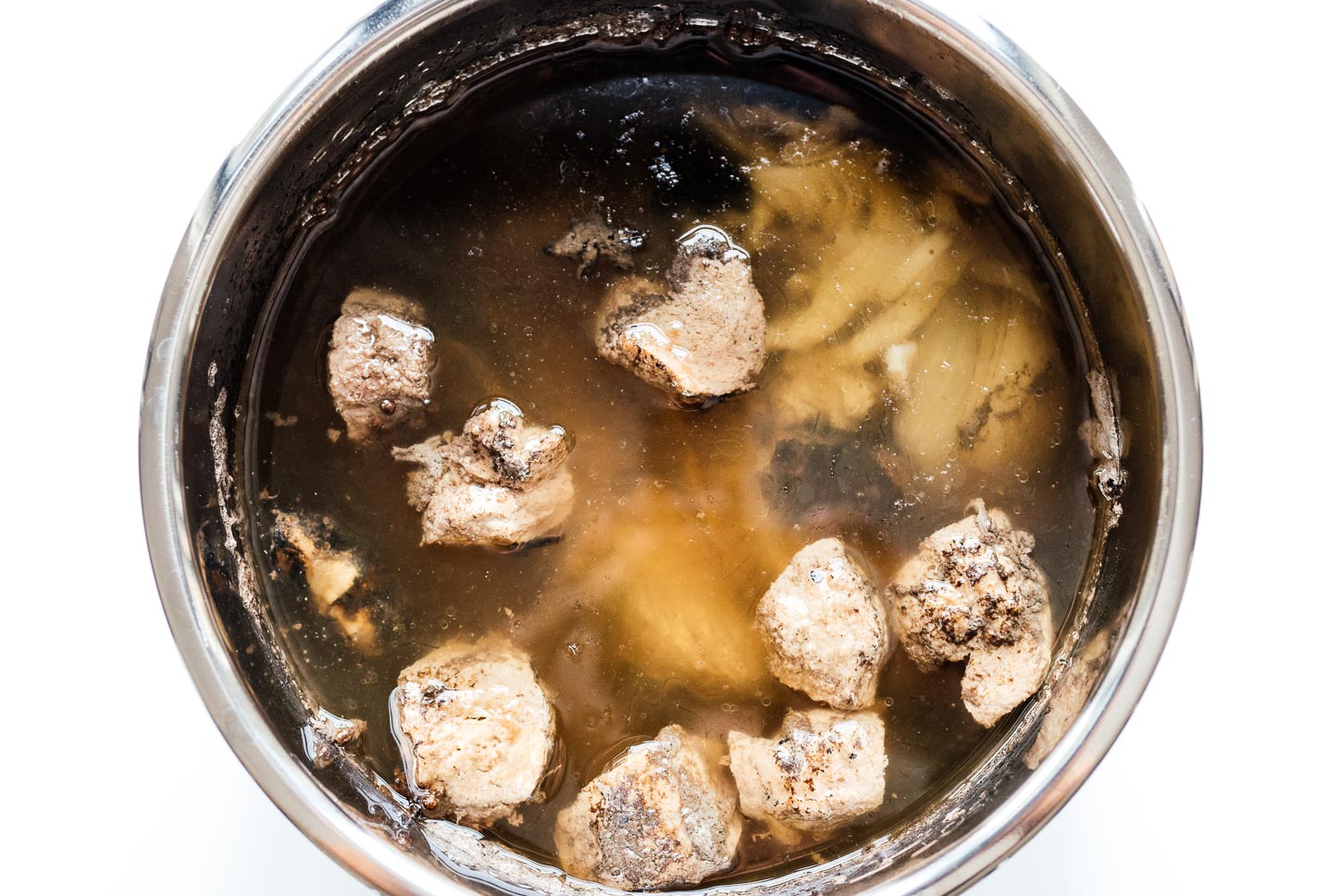
How to make pho on the stove
- Char your spices and aromatics. Ideally with a blowtorch so you can char all the spices at once, but if you have a grill, broiler, or cast iron pan, just char the onion/shallots, ginger, and cinnamon.
- Boil the bones and meats for 5 minutes to remove most of the scum, then drain. Ideally, wash the pot again too.
- Fill up the pot with the parboiled bones or finger meat, tendons if using, aromatics, and spices along with enough water to cover. Bring to a very gentle simmer and hold it there for 4-6 hours. If you have flank or brisket, add it in 2 hours before the broth is finished cooking.
- Prepare. Just before you intend to eat, prepare the rice noodles, meats, and garnishes while the broth is cooking.
- Season. Add sugar and fish sauce (or salt) until the broth is just about overseasoned. It’ll balance out once you add the noodles.
- Build. Add rice noodles and sirloin in your bowl, then fill the bowl up with about 2 cups (or more) of pho soup. Top with onion and cilantro, then at the table, let everyone add thai basil, bean sprouts, chilies, hoisin, and sriracha to their liking.
- Enjoy!
How to pronounce pho
By now everyone knows to pronounce pho as fuh. But you can be a little closer to the tonal Vietnamese if you pronouce it as if you are asking a question. I think it’s closest if you always pronounce the single word as it sounds at the end of this sentence: “Really?! You want to eat pho?!”
Other phos to make
- Authentic Instant Pot Chicken Pho Recipe
- The Best Instant Pot Vegan Pho Recipe
- Turkey Pho Recipe
- Pho-strami: A Pho-Forward Take on Pastrami
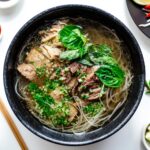

Authentic Pho Recipe
#wprm-recipe-user-rating-0 .wprm-rating-star.wprm-rating-star-full svg * { fill: #f5a623; }#wprm-recipe-user-rating-0 .wprm-rating-star.wprm-rating-star-33 svg * { fill: url(#wprm-recipe-user-rating-0-33); }#wprm-recipe-user-rating-0 .wprm-rating-star.wprm-rating-star-50 svg * { fill: url(#wprm-recipe-user-rating-0-50); }#wprm-recipe-user-rating-0 .wprm-rating-star.wprm-rating-star-66 svg * { fill: url(#wprm-recipe-user-rating-0-66); }linearGradient#wprm-recipe-user-rating-0-33 stop { stop-color: #f5a623; }linearGradient#wprm-recipe-user-rating-0-50 stop { stop-color: #f5a623; }linearGradient#wprm-recipe-user-rating-0-66 stop { stop-color: #f5a623; }
Ingredients
Pho spices and aromatics
- 5 star anise pods
- 1 cinnamon stick
- 1 tsp whole cloves
- 1 tsp coriander seeds
- 1 tsp peppercorns white preferred, black if not
- 1 tsp fennel optional
- 5 cardamom pods optional
- 1/2 medium onion peeled
- 2 inches ginger halved lengthwise
- 1 shallot peeled and halved
For the pho soup
- 2 lbs beef for soup see notes
- 3 inch daikon 1" slices, optional
- 4 qt water
- 2 oz rock sugar ~1/4 cup white sugar, or to taste
- 1/4 cup fish sauce or to taste
- 24 oz dried pho noodles or fresh, see notes
- 8 Vietnamese meatballs or more, cut in halves
- 1 lb sirloin roast thinly sliced
- 1 lb brisket or flank steak
- 1/2 lb tendon optional
- 1/2 lb omasum optional
To serve the pho
- 1/2 cup fresh cilantro roughly chopped
- 1/2 medium onion sliced
- 3 cups bean sprouts blanched if desired
- 1 lime cut into wedges
- 1 bunch Thai basil
- 1 jalapeño sliced
- sriracha
- hoisin sauce
Special Equipment
Instructions
-
Arrange the larger aromatics on a heat proof baking sheet and blow torch until fragrant. Alternately, toast all aromatics in a cast iron pan on the stove or in the oven broiler for a few minutes until fragrant.
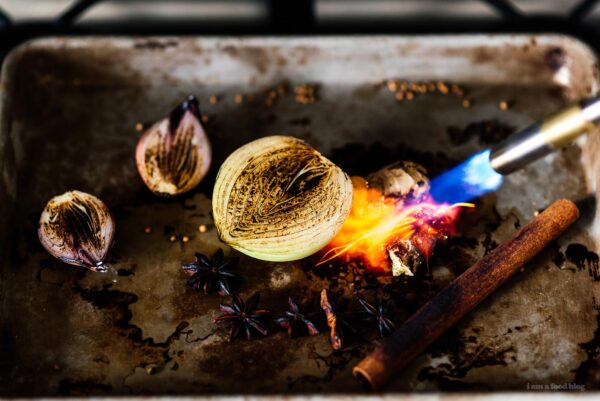
To make the pho soup
-
Transfer charred aromatics along with sugar and all meats except the sirloin to Instant Pot/Pressure cooker. Fill to the max fill line with water, about 4 quarts. Set pressure to high and cook time to 35 minutes and cook. Quick release the pressure when cooking time is completed. See notes for stovetop instructions.
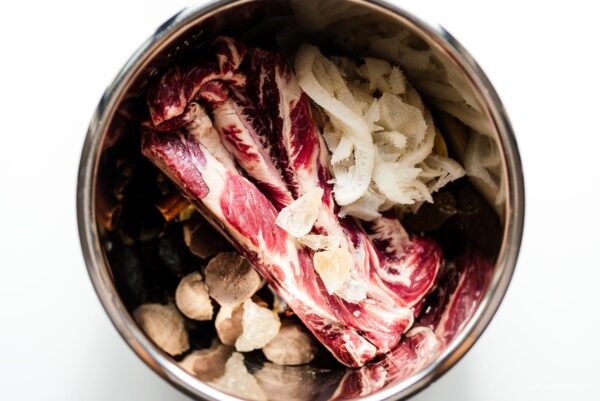
-
Once cool enough to taste, add fish sauce 1 tablespoon at a time until it’s just about overseasoned. Add extra sugar if needed. If you go too far, just add water. You may optionally strain the pho at this point to get as clear of a broth as possible.
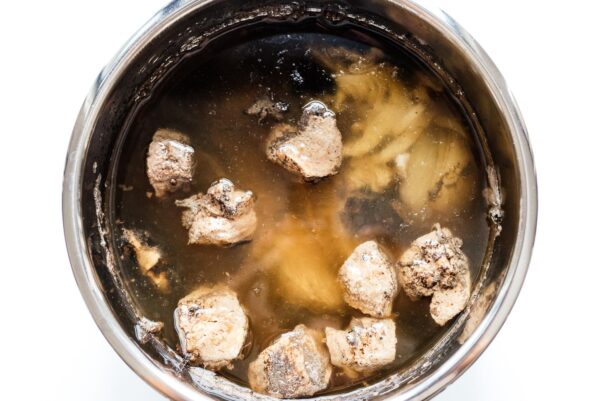
To serve
-
Warm your bowls with hot tap water, then drain. Bring a pot of water to a boil and briefly blanch the noodles, then rinse with cold water and drain well. Divide noodles evenly into each of the warmed bowls. Thinly slice the sirloin (if needed) and top each bowl. Thickly chop all the other meats and divide evenly.
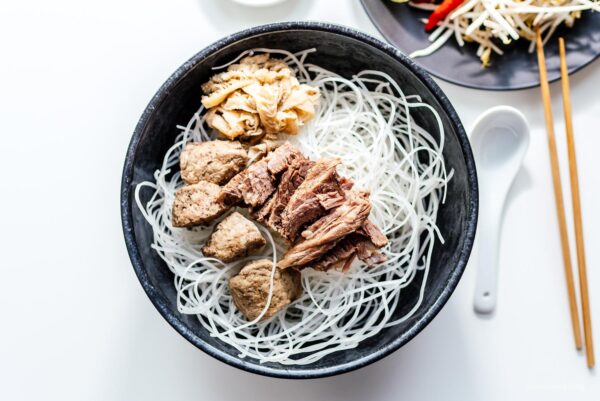
-
Cover with about 2 cups of hot broth per bowl and sprinkle chopped cilantro and sliced onions over top. Serve with a plate of bean sprouts, limes, Thai basil, and chilies. Have small dipping plates of sriracha and hoisin sauces for each person.
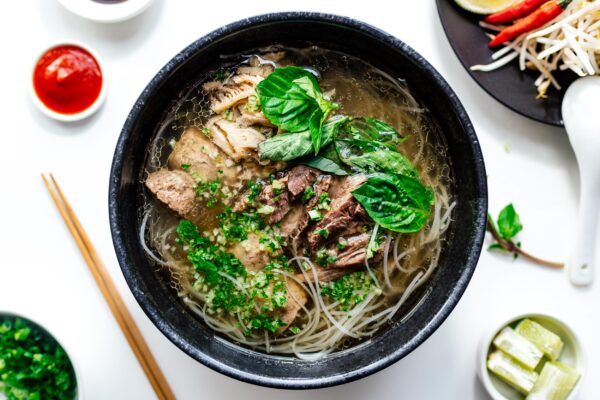
Notes
If you don’t have a pressure cooker, bring the beef to a boil along with enough water to cover for 5 mins, then drain and wash the pot. Add clean cold water and gently simmer the beef, tendons if using, aromatics, and daikon for 4-6 hours. You can do this part in a crockpot as well. Try to maintain the same level of water during the cooking process, checking back every 30 minutes or so. 2 hours before the soup is finished, add the brisket. 20 minutes before serving, add meatballs and tripe.
While the nutrition information is as accurate as possible, it is only representative if you consume all of the broth. It includes 1/2 of meat per bowl, which may be a lot more than you have if you didn't go for the optional meats, and includes 1 tbsp of fat per bowl. If you go with 1 tsp of fat, it is 806 calories, and if you go with no fat, it is 773 calories per bowl.
Estimated Nutrition
Calories from Fat 247



